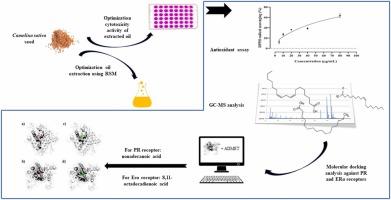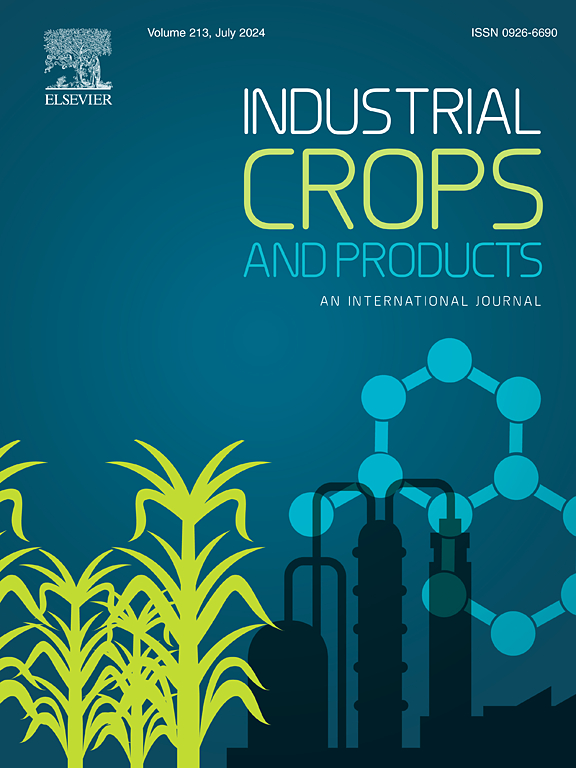Optimizing Camelina sativa oil extraction and its cytotoxicity using RSM by emphasis on antioxidant properties, physical characteristics, and molecular docking insights
IF 5.6
1区 农林科学
Q1 AGRICULTURAL ENGINEERING
引用次数: 0
Abstract
Camelina sativa oil has garnered significant interest due to its potential as a source of natural bioactive compounds. This study focuses on optimizing the extraction of C. sativa oil and evaluating its cytotoxic effects against MCF-7 breast cancer cells using response surface methodology (RSM). The optimal extraction conditions were determined to be a ratio of 9:1 mL/g, with an extraction time of 13.78 min at 60.06℃ for oil extraction (11.69 %, p-value ≤ 0.05), and also a ratio of 6.5:1 mL/g with a time of 10.64 min at 70.18℃ for cytotoxic effect (63.80 %, p-value ≤ 0.05). Gas chromatography analysis identified key components of the oil, including oleic acid (23.44 %), 8,11-octadecadienoic acid (13.48 %), and palmitic acid (6.31 %). The physical properties of the oil, such as refractive index (1.469), density (0.9132 g/cm³), and viscosity (0.9103 g/cm³) were also characterized. The extracted oil displayed antioxidant activity with a DPPH IC50 value of 78.40 µg/mL. Molecular docking studies revealed stable interactions between the oil components and critical residues in the active sites of estrogen and progesterone receptors linked to breast cancer. ADMET analysis indicated compliance with Lipinski's Rule of Five, although varying solubility and absorption characteristics were noted. Overall, C. sativa oil exhibited promise as a dual-functioning agent with both anticancer and antioxidant properties, highlighting the necessity for further research to confirm its therapeutic potential.

利用 RSM 优化荠菜油提取及其细胞毒性,重点关注抗氧化特性、物理特性和分子对接见解
亚麻荠油因其作为天然生物活性化合物的潜在来源而获得了极大的兴趣。本研究旨在优化芥花油的提取工艺,并利用响应面法(response surface methodology, RSM)评价其对MCF-7乳腺癌细胞的细胞毒作用。最佳提取条件为:比例为9:1 mL/g,在60.06℃条件下提取时间为13.78 min(11.69 %,p值≤0.05);比例为6.5:1 mL/g,在70.18℃条件下提取时间为10.64 min(63.80 %,p值≤0.05)。气相色谱分析鉴定出油的主要成分为油酸(23.44 %)、8,11-十八二烯酸(13.48 %)和棕榈酸(6.31 %)。表征了该油的折射率(1.469)、密度(0.9132 g/cm³)和粘度(0.9103 g/cm³)等物理性质。提取油具有抗氧化活性,DPPH IC50值为78.40 µg/mL。分子对接研究表明,与乳腺癌相关的雌激素和孕激素受体活性位点的关键残基与油成分之间存在稳定的相互作用。ADMET分析表明,虽然注意到溶解度和吸收特性的变化,但符合Lipinski的五定律。总的来说,芥蓝油具有抗癌和抗氧化双重功能,需要进一步研究以证实其治疗潜力。
本文章由计算机程序翻译,如有差异,请以英文原文为准。
求助全文
约1分钟内获得全文
求助全文
来源期刊

Industrial Crops and Products
农林科学-农业工程
CiteScore
9.50
自引率
8.50%
发文量
1518
审稿时长
43 days
期刊介绍:
Industrial Crops and Products is an International Journal publishing academic and industrial research on industrial (defined as non-food/non-feed) crops and products. Papers concern both crop-oriented and bio-based materials from crops-oriented research, and should be of interest to an international audience, hypothesis driven, and where comparisons are made statistics performed.
 求助内容:
求助内容: 应助结果提醒方式:
应助结果提醒方式:


